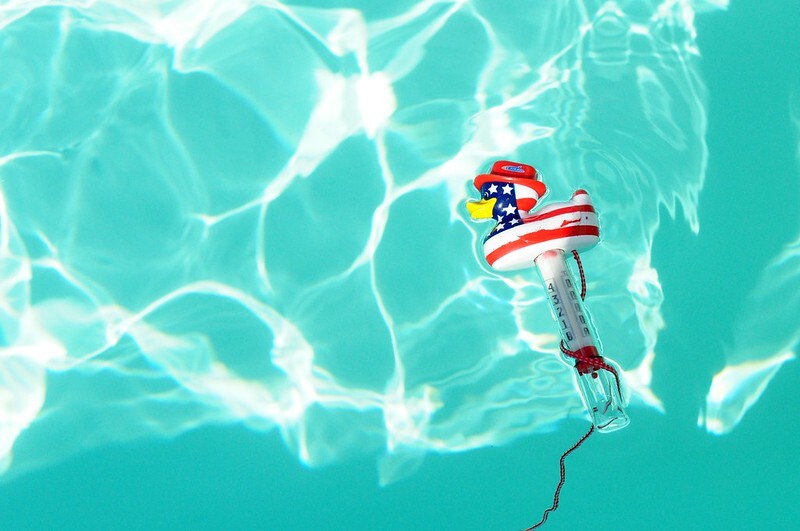Summer is on its way, and although it’s hot outside, you may wonder if the pool water still needs to stay at a certain temperature. The answer is “yes.” But why is this? Adults have an easier time tolerating cold water during recreational activities––meaning anything that’s not intensive exercise, such as lap swimming.
Although swim lessons require some movement, the reality is that some students don’t move around enough to stay warm, such as in competitive swimming. The typical competitive swimmer would prefer a water temperature of about 77-82 degrees; anything higher than that feels too hot due to the duration and intensity that swim team workouts require.
Average Pool Temperature of Public Pools
In my few years as a lifeguard and swim instructor, I’ve found that most commercial pools have difficulty finding the perfect pool temperature that suits all activities. Therefore, many of them keep the pool between 82-86 degrees (lower in the summer, and higher in the winter) to accommodate both family swim and lap swim.
Ideal Pool Temperature
For general swimming, 84 degrees is the sweet spot. Since it’s in the middle of “cold” and “warm” (in terms of pool temperature), it can accommodate a variety of activities: synchronized swimming, water aerobics, and kids swim, to name a few. The mid-80s range also works well because having more bodies in the pool can actually make the water feel warmer due to the residual body heat.
Comfortable Pool Temperature for Lap Swimming
However, those who have swam in gym pools may know that lap swimming requires a lower pool temperature. Some gyms––such as LA Fitness––keep their water temperature cooler for patrons who have longer workouts. Gym pool temperatures are typically 80-82 degrees, on top of being in a room with an already cooler air temperature. Distance swimming is my specialty, so I know that overheating during less-intense swims is still possible if you’re swimming long enough because the body can still give off quite a bit of heat from all the movement.
This is the same reason that kids can often stay in the pool on a hot summer afternoon for a couple of hours without getting chilled; splashing around or playing games like Marco-Polo keeps them moving and warm. Swim lessons, on the other hand, require higher temperatures. The nice thing about having your own pool is that you can keep the temperature at whatever level you desire. But how do you decide what that “ideal” pool temperature is?
Best Pool Temperature for Swim Lessons
Thankfully, the American Red Cross, an authority in the aquatics field, has developed water temperature guidelines with specific age groups and lesson lengths in mind. All temperatures are in Farenheit:
- Infant or preschool: > 89.6° for 20-30 minutes
- Learn-to-swim (ages 6-15): > 82.4° for 30-45 minutes
However, the United States Water Fitness Association also provides more nuanced guidelines for children in younger age groups:
- Preschool: 88-94°
- 3-5 years: 86 to 90°
- 6-13 years: 84 to 86°
Looking at these numbers, we can see a common theme: older children have an easier time tolerating a more “normal” water temperature, but the little ones really need something much warmer. Why? It’s because younger children are more prone to heat-loss due to having a faster heat loss rate than adults and a greater surface area compared to their body mass.
Not only that, but having little activity in water that’s not “warm enough” can lead to a child feeling uncomfortable. Having a comfortable water temperature is especially important for infants and toddlers since they’re getting used to a new environment. Therefore, the cold water could make these little ones cry instead of wanting to explore the water and the recommended pool temperature for babies is higher.
These are just suggested ranges, but if you’re in doubt, consider the activity level. For example, a 12-year-old who’s working on butterfly and flip turns will exert a lot of energy that will keep them warm. A 4-year-old working on floats, on the other hand, will expend less energy and is more likely to become cold easily.
Ideal Swimming Pool Temperature in the Summer
Since hot summers can warm up the water quite a bit, especially on 90° days, you can experiment with the temperature on a day when your child doesn’t have a swim lesson. Heat the pool to your desired temperature in the morning, turn the heater off, and then measure the water temperature again in the afternoon. If there’s a decent increase from the heated pool temperature (at least 2 degrees), then you could probably turn the heater down and turn it back up in the evening.
If in doubt, warmer water is always better. Check your pool temperature at least two hours before your child’s lesson begins to make sure it’s at the perfect temperature. This way, you’ll know that they will stay comfortable and happy during their swim lesson.
Would you like swimming lessons in the convenience of your own pool? At Sunsational Swim School, our experienced swimming instructors come to your pool! Learn more today about our private at-home swim lessons and see if we service your area!
Jehn Kubiak’s bio:
Swim Instructor in Los Angeles, CA
Jehn is an aspiring aquatics manager who has lifeguarded for five years and taught swim lessons for three. Jehn has mostly taught for private swim schools, but she is also a certified American Red Cross Water Safety Instructor. Although Jehn loves teaching, she’s also a nerd about pool operations who thoroughly enjoys testing and balancing chemicals.
ABOUT SUNSATIONAL SWIM SCHOOL
Sunsational Swim School is the 🥇 #1 rated provider of private, at-home swimming lessons in America. We have specialized swim instructors for students ages 6 months to adult, beginner to advanced. Featured on ABC, CBS, Impact 100, The List and others, Sunsational instructors have a minimum of 2 years of teaching experience, are CPR certified and insured, and have collectively taught over 302,223 lessons for more than 74,415 students nationwide!




